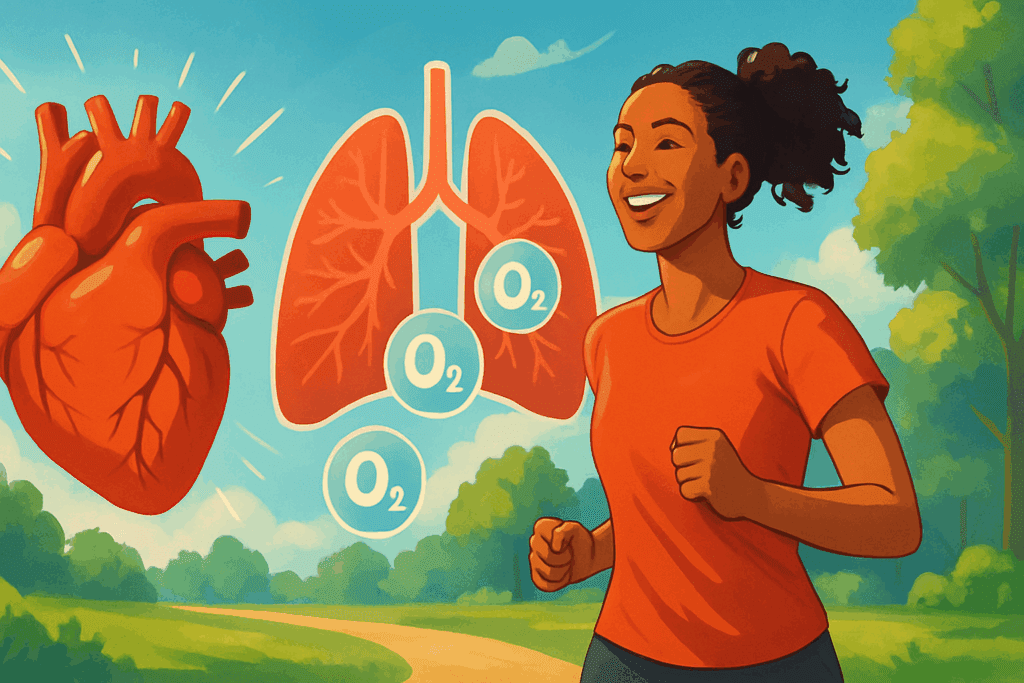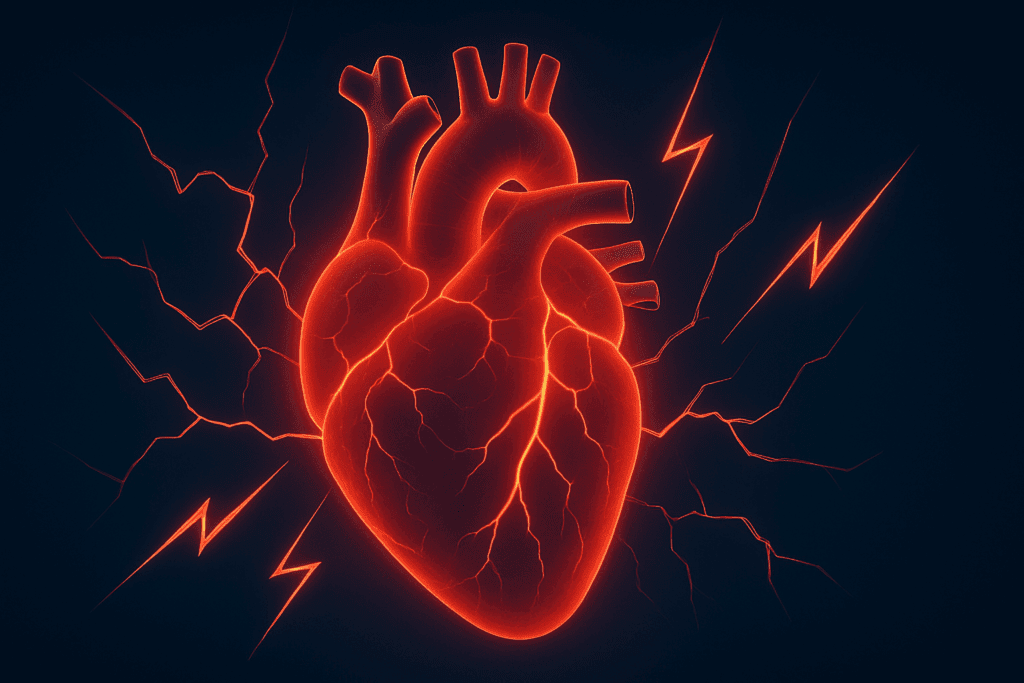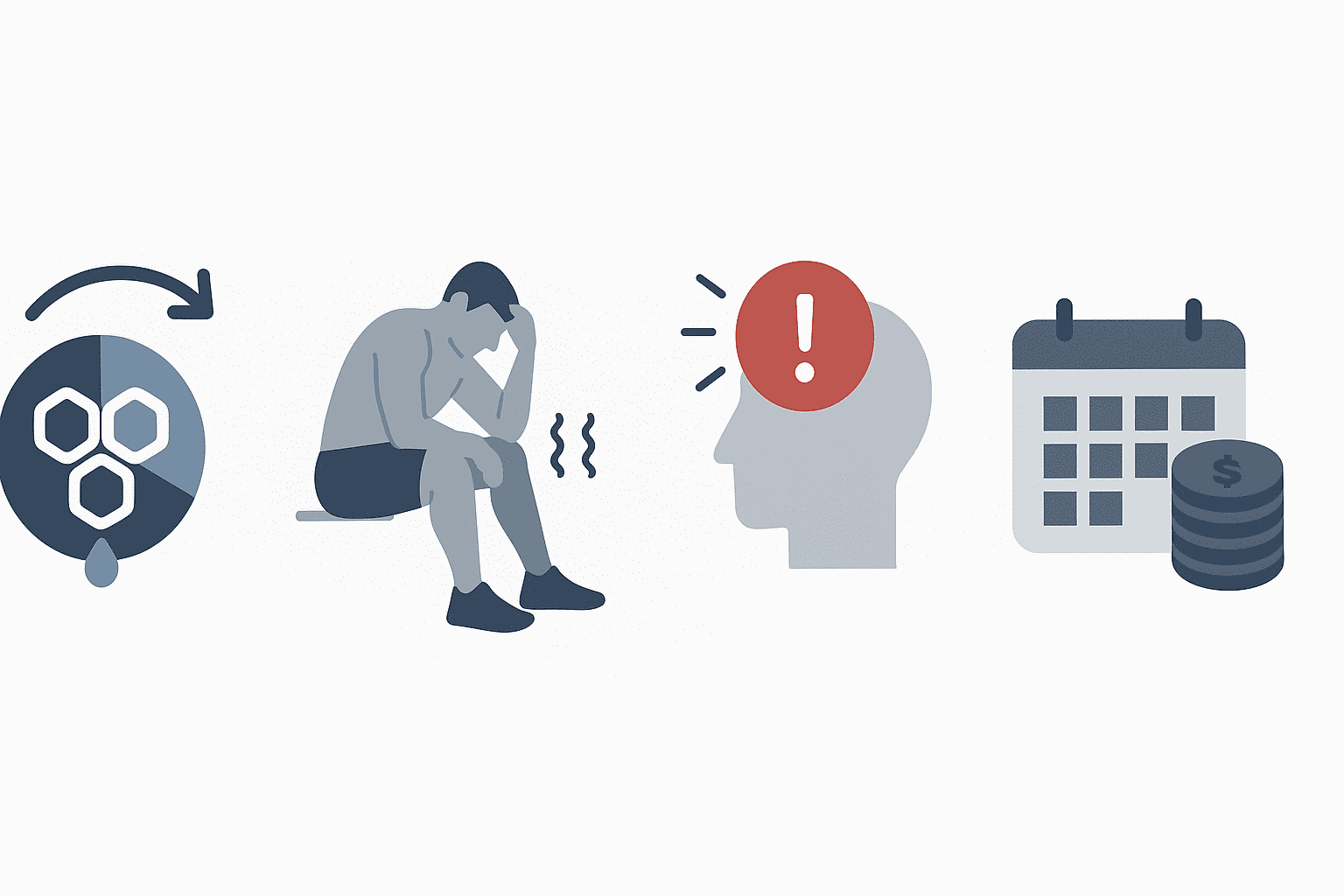In the world of fitness and performance enhancement, cardiovascular exercise has long been championed as an essential component of a well-rounded health regimen. From lowering blood pressure and improving heart function to supporting mental clarity and reducing the risk of chronic disease, the benefits of cardio are vast and well-documented. Yet, as with most aspects of health and wellness, there comes a point where more is not necessarily better. As the popularity of endurance sports like marathons, triathlons, and long-distance cycling continues to grow, so too does the need to ask an increasingly relevant question: how much cardio is too much?
You may also like: Smart Nutrition Choices for a Healthier Lifestyle: What to Know About Whole Grain Rice and Whole Wheat Rice

Understanding the Benefits of Cardiovascular Exercise
Before delving into the risks of excessive cardio, it’s important to understand why cardiovascular exercise is held in such high esteem. Regular aerobic activity strengthens the heart, increases lung capacity, and improves the efficiency with which the body utilizes oxygen. It also plays a key role in metabolic health, aiding in the regulation of blood sugar and cholesterol levels, and assisting with fat oxidation. These physiological benefits contribute to increased stamina, improved mood, and even better cognitive performance.
Many health professionals recommend moderate-intensity aerobic exercise for at least 150 minutes per week, or vigorous-intensity exercise for 75 minutes, as outlined by the World Health Organization. These guidelines provide a solid foundation for general health and are not typically associated with any adverse outcomes. However, for those pushing well beyond these recommendations, particularly with high volumes of high-intensity training, the question arises: can you do too much cardio?

Can You Do Too Much Cardio? Recognizing the Warning Signs
The short answer is yes. While cardiovascular exercise is undeniably beneficial, too much cardio can strain the body and lead to diminishing returns. Overtraining syndrome, a condition characterized by fatigue, hormonal disruption, and a decline in performance, is a common result of excessive cardio. The body, when pushed beyond its limits without sufficient recovery, enters a state of chronic stress. Cortisol levels rise, inflammation increases, and the immune system becomes compromised.
Athletes and fitness enthusiasts alike should watch for warning signs that they may be doing too much cardiovascular exercise. Persistent muscle soreness, chronic fatigue, elevated resting heart rate, insomnia, irritability, and frequent illness can all signal that the body is overwhelmed. When exercise begins to feel more like a compulsion than a source of enjoyment or vitality, it’s often a red flag that balance has been lost.
How Much Cardio Is Too Much Cardio for the Average Person?
Determining how much cardio is too much cardio depends largely on the individual. Factors such as age, fitness level, overall health status, and training goals must all be considered. For the average person simply looking to stay fit and healthy, excessive cardio is typically unnecessary and even counterproductive. Pushing past the optimal threshold can lead to muscle loss, hormonal imbalance, and an increased risk of overuse injuries.
For example, engaging in 2 hours of cardio a day, especially at high intensities, may be excessive for many individuals. This volume of training, unless carefully structured and supported by proper nutrition, hydration, and rest, can place undue strain on the body. It’s crucial to remember that fitness gains are not solely about duration or volume, but also about quality and recovery.
When Is It Bad to Do Cardio Every Day?
One common question that arises is, is it bad to do cardio everyday? While daily movement is encouraged, performing high-impact or high-intensity cardio sessions every day can lead to burnout. The body needs time to rebuild and strengthen after training. Without rest days or active recovery sessions, the risk of injury and fatigue increases.
Incorporating variety into a weekly training plan can mitigate the risks of doing too much cardio. Alternating between steady-state cardio, high-intensity interval training (HIIT), and low-impact activities such as swimming or walking can help the body recover while still maintaining cardiovascular fitness. Rest days are not a sign of weakness but a necessary part of progress.

The Science Behind Too Much Cardiovascular Exercise
Emerging research is shedding light on the physiological consequences of excessive cardio. Studies have found that endurance athletes engaging in prolonged, high-volume cardio may experience structural changes to the heart, including atrial fibrillation and myocardial fibrosis. While these conditions are not common among recreational exercisers, they underscore the importance of understanding the potential risks of long-term, high-intensity endurance training.
Additionally, too much cardio can impair the endocrine system. For instance, excessive cardiovascular exercise has been linked to disruptions in the hypothalamic-pituitary-adrenal (HPA) axis, which regulates stress hormones and reproductive function. In extreme cases, this can lead to amenorrhea in women and reduced testosterone levels in men. These hormonal changes not only affect performance but also impact mood, libido, and long-term health.

Too Much Cardio Exercise and the Muscle Paradox
Another potential downside of excessive cardio is its effect on muscle mass. While aerobic exercise is excellent for heart and lung health, it does not build muscle in the same way resistance training does. In fact, too much cardio exercise—particularly when performed in a fasted state or without adequate protein intake—can contribute to muscle breakdown. This catabolic state is detrimental for those seeking a balanced, strong physique.
Resistance training complements cardio by building lean muscle, which supports metabolic health, improves posture, and enhances overall strength. Integrating both modalities into a training program allows for a more comprehensive approach to fitness. This balanced strategy helps prevent the common pitfall of prioritizing cardio at the expense of muscular development.
Finding the Right Balance: Quality Over Quantity
In the pursuit of health, more is not always better. The concept of “minimum effective dose” is useful when considering how much cardio is enough. This approach encourages individuals to focus on the least amount of training needed to achieve desired outcomes, rather than chasing excessive volumes that may lead to diminishing returns. By emphasizing quality over quantity, individuals can improve performance while reducing the risk of injury or burnout.
Working with a knowledgeable fitness professional or coach can help tailor a cardio plan that aligns with individual goals and capacities. Personalized programming, built on sound exercise science and real-world experience, allows for progressive adaptation without overreaching. Tracking heart rate variability, monitoring sleep, and journaling perceived exertion are tools that can aid in evaluating whether you’re toeing the line of too much cardio.

Excessive Cardio and the Mental Health Connection
Beyond the physical effects, the psychological toll of excessive cardio is an important consideration. For some, exercise can become compulsive, driven more by anxiety or body image concerns than by a desire for health. This behavior, often associated with conditions like exercise addiction or orthorexia, can impair relationships, reduce quality of life, and paradoxically undermine the mental health benefits typically associated with physical activity.
Recognizing when cardio has shifted from a healthy habit to a harmful obsession is critical. Mental health professionals, alongside fitness experts, can help individuals reframe their relationship with exercise. Emphasizing mindful movement, body awareness, and self-compassion can guide the way toward a more balanced and sustainable approach to fitness.
Redefining Endurance: Smarter Training for Long-Term Success
Endurance training, when approached with intention and strategy, offers immense rewards. However, redefining what it means to be an endurance athlete can help prevent the trap of overtraining. Rather than focusing solely on time, distance, or calorie burn, consider metrics such as recovery rate, consistency, and overall well-being. These indicators provide a more holistic view of progress and longevity in fitness.
Integrating periodization—planned phases of training and rest—into a cardio routine can also mitigate the risks associated with too much cardiovascular exercise. Periodization ensures that the body is not constantly subjected to the same stressors, which reduces the likelihood of plateaus and injuries. Whether training for a marathon or simply staying active, strategic variation is key.

What Happens When You Do 2 Hours of Cardio a Day?
Engaging in 2 hours of cardio a day is a common scenario for those training for endurance events or attempting rapid weight loss. While such volume may be appropriate in specific contexts under professional supervision, it often poses risks when adopted without proper planning. Extended cardio sessions can lead to glycogen depletion, muscle fatigue, and increased cortisol levels, which can ultimately hinder recovery and adaptation.
In addition to physical concerns, long cardio sessions can impact daily life, limiting time for other essential activities like social interaction, strength training, or relaxation. The opportunity cost of spending hours on a treadmill or bike each day should not be overlooked. Fitness should enhance life, not consume it.
Creating Sustainable Cardio Habits That Support Total Health
Sustainability should be at the heart of any training plan. For cardio to be truly beneficial, it must be integrated into a broader lifestyle that includes balanced nutrition, quality sleep, and stress management. A well-rounded approach not only prevents the dangers of too much cardio but also maximizes the physical and psychological rewards of consistent movement.
Listening to the body is a fundamental skill that helps navigate the fine line between dedication and overexertion. If cardio leaves you energized, strong, and mentally clear, it’s likely being used in appropriate amounts. But if it results in fatigue, irritability, or declining performance, it may be time to reassess your approach.
The Role of Recovery in Preventing Cardio Burnout
Recovery is not a passive process—it is an active and necessary component of athletic success. Incorporating rest days, sleep optimization, hydration, and nutrient-dense meals supports recovery and enhances the body’s ability to adapt to training. Techniques such as foam rolling, massage, and stretching can also help reduce the muscular and systemic strain associated with cardiovascular training.
Athletes who embrace recovery as part of their training often outperform those who neglect it. This is especially true when cardio volume increases. The body can only grow stronger during rest, not during exercise itself. Recognizing this truth is essential for long-term endurance and stamina gains.
Frequently Asked Questions: Understanding the Limits and Risks of Cardiovascular Exercise
1. Can you do too much cardio without realizing it? Yes, it’s surprisingly easy to slip into a pattern of doing too much cardio, especially when progress plateaus or when exercise becomes a form of stress relief. The tricky part is that the signs can be subtle at first—like a slight dip in energy, poorer sleep, or more frequent colds. These early signals often go unnoticed or are brushed off as temporary. Over time, however, the cumulative strain can lead to excessive cardio-related complications, such as hormonal imbalances or decreased immune resilience. Athletes and casual exercisers alike should regularly reassess their training routines and energy levels to avoid pushing beyond what their body can sustain.
2. How much cardio is too much for someone trying to build muscle? When muscle growth is the primary goal, cardio should complement strength training, not compete with it. For most people, more than 30–45 minutes of moderate-intensity cardio five times per week may begin to interfere with hypertrophy if not managed properly. The question of how much cardio is too much depends largely on nutritional intake, training intensity, and recovery habits. Excessive cardio sessions can lead to muscle catabolism, especially in a calorie deficit. To build muscle effectively, it’s wise to limit high-volume cardio and prioritize resistance training, ensuring adequate protein intake and rest to support anabolic processes.
3. Is it bad to do cardio everyday if I vary the intensity? Not necessarily. The phrase “is it bad to do cardio everyday” deserves nuance. If your cardio routine includes variation in intensity—like alternating between brisk walking, light cycling, and occasional intervals—it can be sustainable and beneficial. The problem arises when every session is high-intensity and recovery is compromised. Varying the intensity and type of cardio reduces the risk of too much cardiovascular exercise, supports different muscle groups, and helps avoid mental burnout. As long as the volume is appropriate and you listen to your body’s signals, daily movement can be both safe and productive.
4. What happens to your metabolism with too much cardio exercise? In the short term, cardio boosts metabolism, but excessive cardio may trigger adaptive thermogenesis—a process where the body becomes more efficient and burns fewer calories over time. This metabolic adaptation is a survival response to prolonged energy expenditure. The body may begin to conserve energy, reduce non-exercise activity, and slow resting metabolic rate. This is why too much cardio exercise can paradoxically hinder weight loss or cause a plateau. A balanced program that includes resistance training, rest, and adequate nutrition prevents this metabolic downshift.
5. Can 2 hours of cardio a day increase the risk of injury? Yes, especially if the cardio includes repetitive, high-impact activities like running or stair climbing. Performing 2 hours of cardio a day without adequate cross-training or recovery increases the strain on joints, tendons, and muscles. Over time, microtraumas may accumulate, leading to overuse injuries such as shin splints, tendinitis, or stress fractures. The risk is magnified if form deteriorates due to fatigue or if supportive footwear is neglected. While elite athletes may train at this volume under supervision, for most individuals, 2 hours of cardio a day is unsustainable and potentially harmful without proper structure.
6. What are the emotional signs of too much cardio? Beyond physical exhaustion, emotional and psychological shifts can indicate excessive cardio. Mood swings, heightened anxiety, lack of motivation, and even feelings of guilt for skipping a workout are common. These symptoms often accompany overtraining but are less talked about. If you’re constantly preoccupied with workout schedules, find it difficult to rest without feeling uneasy, or experience diminishing joy from your sessions, these may be signs of too much cardio. Recognizing the emotional toll is just as important as watching for physical red flags.
7. How can I tell if I’m doing too much cardiovascular exercise without performance tests? While lab-based performance tests are helpful, you can detect signs of too much cardiovascular exercise through personal monitoring. Metrics like resting heart rate, heart rate variability, perceived exertion, and sleep quality are practical indicators. For example, an elevated morning resting heart rate may signal insufficient recovery. Decreased motivation or a constant sense of fatigue also suggest that training volume may be too high. These real-world markers help individuals intuitively gauge how much cardio is too much cardio without relying solely on formal testing.
8. Is too much cardio bad for hormonal health in women? Absolutely. Hormonal health is especially sensitive to excessive cardio, particularly when paired with inadequate caloric intake. Women who overtrain may experience disruptions in the menstrual cycle, including amenorrhea, due to lowered estrogen levels. This hormonal imbalance not only affects reproductive health but also bone density, mood, and metabolism. In women, understanding how much cardio is too much requires close attention to energy availability and symptoms. Reducing cardio frequency, eating more nutrient-dense food, and ensuring rest days are key to restoring hormonal balance.
9. Does excessive cardio affect sleep patterns? Interestingly, while moderate cardio improves sleep, excessive cardio may have the opposite effect. Overtraining, especially late in the day, can elevate cortisol levels, making it harder to fall asleep or stay asleep. Poor sleep, in turn, impairs recovery and increases the likelihood of doing too much cardio unintentionally. Sleep disturbances often go overlooked as a symptom of overtraining but are crucial for athletic performance and recovery. Monitoring sleep quality, particularly after intense or extended sessions, can reveal if your cardio routine is tipping into excess.
10. What are smarter alternatives to doing high-volume cardio daily? For those seeking endurance or fat loss without risking too much cardio, smart training strategies offer a better path. Incorporating high-intensity interval training (HIIT) two to three times a week can yield greater cardiovascular and metabolic benefits in less time. Pairing moderate cardio with resistance training ensures more sustainable results and protects muscle mass. Additionally, integrating rest, mobility work, and even mindfulness practices into your routine can help counteract the stress of too much cardiovascular exercise. Rather than asking “can you do too much cardio,” the more empowering question becomes, “how can I train more efficiently?”
Conclusion: Understanding How Much Cardio Is Too Much for Optimal Health and Performance
In the quest for peak fitness and endurance, cardio remains an invaluable tool. However, like any powerful tool, its benefits hinge on how wisely it is used. Recognizing how much cardio is too much is not about restricting movement but about optimizing it. Whether you’re a seasoned athlete or a dedicated gym-goer, it’s essential to understand when cardiovascular training becomes excessive.
When signs of overtraining appear—persistent fatigue, hormonal disruption, or mental burnout—it’s time to recalibrate. Asking questions like “is it bad to do cardio everyday?” or “how much cardio is too much cardio?” is not a sign of weakness but a reflection of wisdom and self-awareness. Through expert insights, intentional training plans, and a deep respect for the body’s need for balance, you can enjoy the many rewards of cardiovascular fitness without crossing into the territory of excessive cardio.
Ultimately, your health and performance are best served not by more cardio, but by smarter cardio. Use evidence-based strategies, listen to your body’s cues, and prioritize recovery. In doing so, you’ll be able to harness the full power of cardio while safeguarding your longevity, energy, and overall well-being.
Was this article helpful? Don’t let it stop with you. Share it right now with someone who needs to see it—whether it’s a friend, a colleague, or your whole network. And if staying ahead on this topic matters to you, subscribe to this publication for the most up-to-date information. You’ll get the latest insights delivered straight to you—no searching, no missing out.
Further Reading:
How Much Cardio Is Too Much? We Asked the Experts
Are You Exercising Too Much? Here’s How to Tell (and Why It Can Be Risky)

